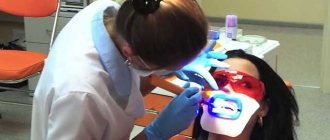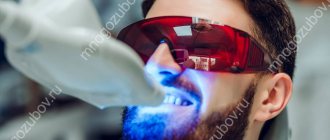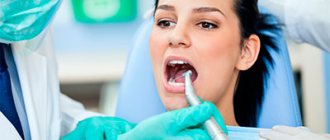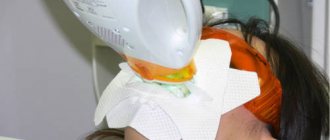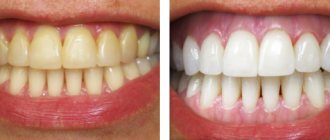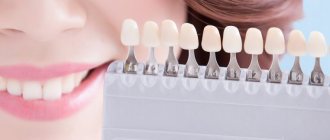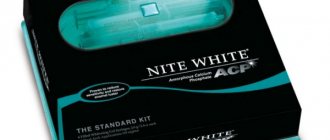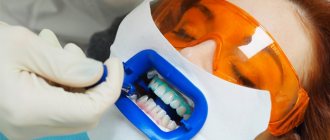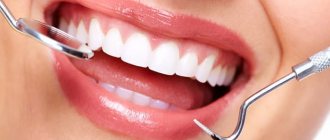Author of the article:
Soldatova Lyudmila Nikolaevna
Candidate of Medical Sciences, Professor of the Department of Clinical Dentistry of the St. Petersburg Medical and Social Institute, Chief Physician of the Alfa-Dent Dental Clinic, St. Petersburg
Cold lamp teeth whitening is one of the most modern ways to lighten enamel. The procedure is carried out using a special LED lamp with cold light.
This method is often confused with whitening with a conventional incandescent lamp, which heats the enamel, which is unsafe for the teeth, as it leads to their cracking, and also causes a lot of unpleasant sensations during the process itself. It is no wonder that patients are often distrustful of lamp bleaching.
The impact of an LED lamp is very different from a standard one; Let's figure out how effective and safe it is, and whether we should be guided by old stereotypes.
The essence of lamp whitening
It cannot be said that in this procedure, whitening occurs thanks to the light produced by the LED lamp. The bottom line is that light is only a catalyst for a chemical reaction between the reagent and the pigments that are inside the enamel and are responsible for its color.
In order to neutralize the yellow tint, a special gel based on hydrogen peroxide is applied to the teeth. Light exposure to this substance activates oxygen, which penetrates the tooth tissue and oxidizes pigments. Thus, light rays stimulate the chemical process, making the procedure safer and faster.
The main advantage of this method is that the light from the LED lamp practically does not heat the enamel, and therefore does not harm it.
Procedure technology.
Teeth whitening with cold light takes about an hour; first, the dentist must prepare the enamel, examine the oral cavity, remove stone and plaque. The process will be complicated by the presence of carious formations; they need to be cured and filled; there is no point in lightening damaged surfaces. It is also recommended that about a week before starting the procedure, you should exclude coloring foods from your diet and brush your mouth only with white toothpastes. If the patient has no diseases or contraindications that would interfere with whitening, the dentist can begin work.
Preparation.
For convenience, a special retainer is used - a retractor, which holds the jaw in the desired position. It helps the patient to relax his mouth and not tense during the entire procedure, and to prevent his lips from cracking, they are moisturized with cream. Exposure to a halogen lamp harms soft tissues, so liquid rubber dam is applied to them. It hardens within 20 seconds, isolating the gums from aggressive influences.
Lightening.
A special whitening gel is applied to the enamel and with the help of the rays of the Beyond device, the surface of the teeth begins to change. The interaction of peroxide and cold light occurs, active oxygen is released, which penetrates into the dentin, destroying dark pigments. After 10 minutes of treatment, the dentist removes the remaining substance and applies a new portion of the solution. This must be repeated three times.
Final.
Any cosmetic procedure affects the structure of the enamel; to restore it, after the action of the Beyond device, the surface of the teeth is covered with special varnishes and fluoride-containing pastes.
Cold teeth whitening: stages
Enamel lightening with gel and a lamp is exclusively an in-office procedure that should be performed by a trusted specialist. Otherwise, you risk damage to the enamel, irritation of the oral mucosa and other problems.
The whitening itself lasts about an hour and is carried out in several stages.
Preparation
Before any whitening, no matter which method you choose, you should prepare your teeth very carefully:
- Firstly, this concerns the elimination of various scratches and chips on the enamel, as well as the treatment of caries. If you don't do this, the active gel may get into the cracks and act too deeply on the tissue, which will cause you a lot of discomfort both during and after the procedure.
- Secondly, pay special attention to fillings and implants; their color will not change due to bleaching, so it is better to choose temporary options and install permanent ones after the procedure. Otherwise, the color of your smile will not be uniformly white.
- Thirdly, mechanical or ultrasonic cleaning is always necessary before whitening; it will remove soft and hard plaque from the teeth, which will help determine the natural color of your enamel as accurately as possible. Cleaning itself will make your smile one or two shades brighter. Next, you can choose the color of the enamel using a special VITA scale. Next, the bleaching itself begins.
Stages
- The first stage begins with preparing the oral cavity for the procedure; this is necessary to protect the soft tissues. The cheeks and lips are isolated using various napkins and films so that the gel does not accidentally come into contact with them when treating teeth. A protective composition is also applied to the gums so that the aggressive effects of the gel do not cause irritation and other problems. The most popular option is liquid rubber dam; the advantage of this composition is that it quickly hardens, forming a dense protective film.
- The second stage is the whitening procedure itself, the surface of the teeth is thoroughly dried and then evenly coated with the active composition. Next, the teeth are irradiated with an LED lamp for about 10 minutes and the gel is removed. If the color is not white enough, the procedure is carried out again. During one visit to the dentist, it is possible to make no more than three approaches.
- Special restorative compounds are applied to the teeth.
The whole procedure takes about an hour. The result is individual for everyone, so do not despair if you did not get the desired color on your first visit; most likely, with repeated procedures you will achieve the desired shade.
Philips Zoom 4 – an innovative teeth whitening system in the clinic and at home
Whitening without harming your enamel in just 45 minutes - with Philips ZOOM! WhiteSpeed made it possible!
Philips Zoom is the #1 brand for patients in the US who want a whiter smile. And for good reason: the system whitens teeth more effectively than other means.
Clinically proven results
The system allows you to whiten your teeth in 8 shades. To get a luxurious result, you only need 45 minutes plus a little preparation time. Fast, comfortable and safe.
Whitening involves the use of a special gel from the Zoom Chairside set and a new generation LED lamp.
Philips ZOOM! WhiteSpeed guarantees simply stunning results. This is an innovation in the field of teeth whitening. Your clients will be delighted.
How it works
The lamp operates on the principle of LED technology with adjustable light intensity. The step-by-step operation of the lamp looks like this:
- Release of active ions. The gel in the Zoom Chairside kit contains a catalyst. The lamp light activates it, which leads to the effective release of active ions.
- Discoloration of pigment. Active ions act on the double carbon bonds of the chromophore. As a result of this reaction, the yellow pigment becomes discolored.
- Strengthening the effect. Achieved by additional destabilization of carbon bonds due to the effect of the blue light of the lamp on the pigment molecule. Thus, peroxide acts even more effectively on the pigment, bleaching it better and faster.
The main feature and advantage of the method is the instant result that the patient sees immediately after the session.
Benefits of technology for patients
Dental clients who want a snow-white smile love Philips Zoom whitening technology. And that's why:
- The result is visible immediately after the first session - there is no need to undergo a course of procedures or wait for the effect to intensify;
- The nature of the darkening of the enamel does not matter - the Philips Zoom system is in any case;
- The procedure is comfortable - the intensity of the light flux is adjustable, so whitening occurs painlessly;
- Sustainability of the result. It can last for 5 years if the patient takes proper care of his teeth and undergoes maintenance procedures;
- Safety for enamel. After the procedure, the enamel is not damaged, since the pH level of the gel is within the normal range of the oral cavity.
Whitening using Philips Zoom technology is a case where beauty does not require sacrifice.
Important facts about the procedure
Give your patients recommendations to ensure that they enjoy their whitening results for as long as possible:
- After the procedure, temporarily do not consume foods and drinks that can stain the enamel;
- Stop smoking for now.
Warn the patient that in rare cases, dental hypersensitivity may occur in the first few days after the procedure. To prevent discomfort, use a special gel - it will protect the enamel and reduce sensitivity.
Zoom Chairside Set for In-Clinic Whitening
Designed for professional whitening in the dentist's office. The set includes:
- Saliva ejector. Quickly removes ZOOM whitening gel without disturbing the liquidam layer;
- Vitamin E Smoothing Oil - oil with vitamin E. It is used to lubricate soft tissues when irritated by peroxide;
- Cotton rollers – 2 pcs. They are placed in the upper and lower parts of the vestibule of the oral cavity;
- Facial wipes – 2 pcs. They are placed under the retractor. Necessary for insulation;
- Gauze pads. During operation, the lamp protects the soft tissues of the oral cavity;
- Liquidam (liquidam 2.9 g) – 1 pc. The manufacturer has upgraded the insulating material. Now it is 40% more effective and easy to apply due to its viscosity;
- ZOOM gel (hydrogen peroxide 25%) – 2 pcs. Whitening gel with a unique formula. The optimized pH value does not require the use of an activator. It is applied in a thin layer of no more than 1 mm. Store in the refrigerator;
- Universal size IsoPrep retractor – 2 pcs. Retractor with an innovative design that perfectly protects the lips and provides access to the teeth;
- Light guide limiter – 2 pcs. Used to turn on the ZOOM 2 and ZOOM AP lamps. The chip operates for 4 cycles of 15 minutes. It is enough to whiten teeth for one patient;
- EVA 0.1 material for making mouth guards – 2 pcs. Mouthguards are used to reduce tooth sensitivity (then you need to add ReliefGel gel to them) and prolong the results of whitening at home with the NiteWhite and DayWhite systems.
- The set also includes a stylish Patient Kit for dental care after a whitening session. It includes:
- Syringe for home whitening NiteWight ACPF 22%. Allows you to consolidate and maintain the whitening result;
- Relief ACP gel – 1 pc. The desensitizing gel contains potassium nitrate 5% and sodium fluoride 0.22%, as well as calcium phosphate (ACP) for treatment, remineralization, brightening and calcium prevention. The gel permanently fixes the result of the procedure;
- Container – 1 pc. Designed for storing finished aligners.
The set provides high-quality dental care and prolongs the whitening results at home.
Zoom Quick Pro – simple and effective whitening
The two-layer whitening system allows you to whiten your teeth by several shades in 30 minutes. The procedure is so simple and safe for the enamel that dentists perform it even during preventive examinations.
The session takes place in several stages:
- Preparing for bleaching. Applying vitamin E to the lips and installing a retractor.
- Protection. Isolation of the mucosa and installation of cotton rolls.
- Application of the 1st component. It contains hydrogen peroxide 20%. It is kept for 30–40 seconds until the layer hardens.
- Application of the 2nd component. This is a sealant that prevents the active substance from entering the mucous membranes. It is held for another 30–40 seconds.
- Removing the insulation and retractor. Performed only after the last layer has hardened.
- Bleaching. You must wait 30 minutes for the whitening varnish to take effect. It forms a film after application. The patient can go about his business during this time.
- Removing film. This can be easily done with a brush or napkin. Both the dentist and the patient can remove the film.
The Zoom Quick Pro system is the ideal choice if you need to quickly “refresh” your smile.
Who is the Zoom Quick Pro system suitable for?
The benefits of the Zoom Quick Pro system will be appreciated by busy people who do not have time for frequent visits to the dentist.
This is an excellent option for those who have already undergone full clinical whitening and want to maintain the result for a long time - express whitening using Zoom Quick Pro technology fixes it for several years.
This method is also suitable for patients who regularly whiten their teeth at home. If you alternate home treatments with Zoom Quick Pro, the result will be even better.
Clinics that rely on the experience and technology of Western dental clinics should include whitening using the Zoom Quick Pro system in their range of services, since this is truly a super-effective technology. Clients happily return again and again for a Hollywood smile.
ZOOM for home whitening
For patients who use home teeth whitening systems, a ZOOM kit has been developed. It includes:
- Syringes with active ingredients that perfectly whiten teeth without damaging the enamel;
- Nozzles for convenient distribution of gel;
- Materials for making mouth guards individually for the client.
Some kits also include a container to store the aligners.
Benefits of kits for home use
- Convenient to use. The gel and activator are placed in a double-barreled syringe. It is very convenient to mix components before application;
- Simple procedure. To whiten your teeth at home, you only need to mix the activator and gel, apply the mixture into the tray (a drop for each tooth compartment);
- Excellent result. The guaranteed result is whitening up to 6 tones, sometimes it is possible to achieve the effect of up to 8 tones on the Vita scale.
You can offer your patients the Day White or Nite White system.
Day White system
Designed for daytime whitening. The kits are based on hydrogen peroxide. It is very active, so the patient must strictly adhere to the exposure time. According to the instructions, you need to use the gel trays twice a day and leave them on for 30 minutes.
To obtain the result, it is necessary to perform 9–18 applications, depending on the initial condition and color of the enamel.
Nite White system
Designed for whitening at home at night. This is an ideal option if the client is unable to wear the aligners during the day.
The set is based on carbamide peroxide. This is a more gentle substance than hydrogen peroxide. Therefore, the exposure time is 5–7 hours. Teeth are minimally sensitive to this component, so it is ideal for nights when a person cannot always remove the aligners in time.
The whitening course using this system is 9–27 applications.
Disadvantages of decoupling the Philips Zoom 4 lamp
- You lose service once and for all;
- After unchipping, the lamp only works in one mode – intensive. The other two will not work, but they are very relevant;
- The meaning of Zoom 4 technology is lost - the special gel begins to actively work only with this special light.
Summary
If you want to take your dental practice to the next level, offer innovative services. These include whitening using the Philips Zoom 4 system.
Offer it to your patients - and they will no longer be able to refuse a great result. This will increase their loyalty and attract new clients to your clinic.
How effective is teeth whitening with LED light?
Modern cold bleaching is a very effective method. Depending on your individual characteristics, in one visit to the dentist you can lighten your tooth enamel by about 6-10 shades. Provided that your teeth have acquired a yellow tint due to food or smoking. If your enamel has acquired a gray tint, lightening with an LED lamp will not give significant results, that is, the shade will change by 2-3 tones. In addition, the procedure will not work if a change in the healthy color of the enamel is caused by taking tetracycline antibiotics or an excess of fluoride in the body.
The results of whitening with an LED lamp can last for several years, depending on the natural shade of the enamel and how carefully you follow your dentist's recommendations.
Benefits of home whitening
Gentle drugs. Home systems use the same active ingredients as preparations for professional use in a dental office. The difference is in the concentration of such substances and the period of their action. When whitening at home, the contact of the enamel with the bleaching agent lasts from 1-2 to 8 hours. The procedure is repeated several times. Hydrogen peroxide or carbamide peroxide in low concentrations act slowly, gradually, and do not destroy the enamel or increase its sensitivity.
Activation due to a chemical reaction. During in-office bleaching, the active composition can be activated by a lamp. If the dentist makes a mistake at this stage, the pulp may overheat and dehydrate the tooth tissue. Home systems do not have such risks: the lamp is not used, and the active composition is prepared immediately before application. It contains an increased amount of water so that the chemical reaction and the action of the whitening agent do not dehydrate the tooth tissue.
Convenient to use. The patient carries out all procedures himself. For this purpose, elastic mouthguards are used. The product is placed inside them, the trays are put on the teeth and worn for several hours. Daytime whitening systems require wearing for 1-2 hours (the concentration of the active substance is higher). When using night systems, the patient puts on the trays at night, and the gel works while he sleeps.
Stable result. Lightening is carried out gradually, the shade of the enamel changes after each use of the tray. The patient can track and control the lightening of teeth independently. The results of the procedures are stable and with proper care can last for years.
Why does tooth enamel darken?
To get the most out of lamp whitening, you need to understand the causes of darkening of tooth enamel. In most cases, it is enough to eliminate the negative impact and clean the teeth so that the color of the teeth becomes natural again.
Dentin has a dark shade, which shines through a thin layer of enamel. A fair question arises: how does it happen that dentin darkens if the enamel is strong and can protect the tooth from many negative factors?
The reason is quite simple. It lies in the universal love for solid foods and sour drinks. Seeds, nuts, lemonades and other similar products contribute to the deformation of the upper layer of teeth. Through scratches and chips, pigments easily penetrate into the tooth tissue, staining the dentin.
The main factors influencing the color of teeth:
- The most popular reason is the consumption of foods that contain large amounts of coloring substances. These can be the following things: cranberries, blueberries, beets, strawberries, various candies and sodas, coffee, strong tea and much more. If this is the reason for the darkening of your teeth, then careful hygiene and periodic professional cleaning (once or twice a year) will help.
- Change • Change in enamel color is common in smokers. The main problem here is the tar that is in the cigarette. Together with smoke, they fall on the surface of the teeth and settle in the form of a dark plaque. Gradually, this sediment destroys tooth enamel, which can lead to caries and more serious diseases. In addition, smoking also has a negative impact on your gums. The best option in this case would be to quit smoking completely. If this is not possible for you, try to reduce your cigarette consumption to a minimum and pay more attention to oral hygiene.
- The tooth may darken due to injury, which led to damage to the neurovascular bundle. In this case, consultation with a specialist is necessary. Until the cause is eliminated, whitening will not help lighten the tooth.
- The shade may change due to the removal of the nerve; the darkening may not appear immediately, but also requires the intervention of a specialist.
- Filling a canal can lead to staining of the enamel; it all depends on the material used to fill the hole.
- Progressive caries is an advanced case of ordinary caries. The fact is that if such damage is not eliminated, small black spots will increase, destroying the enamel and then the dentin.
- Teeth may have congenital characteristics that are in no way related to caries or other damage. They can differ in structure, tone, shape, and so on. In some cases, it is possible to change their color only with the help of special overlays - veneers.
- Excess fluoride in the water you drink can lead to fluorosis. At the beginning of the disease, dark spots or chalky streaks appear on the teeth. The progression of the disease leads to the destruction of enamel and then dentin. Whitening such teeth is not possible until you get rid of fluorosis.
- Taking tetracycline antibiotics during pregnancy can negatively affect the condition of the baby's teeth.
Professional laser method
Laser whitening is performed in the dentist's office and is not much different from photo whitening. The difference is that the gel applied to the surface of the teeth begins its action not under the influence of light, but under the influence of a laser. Many experts recognize this method as the best among other types of whitening. But patients themselves leave different reviews regarding laser lightening. But in any case, a consultation with a dentist is necessary, since the laser method also has a number of contraindications.
Benefits of lamp teeth whitening
The main advantage of the LED lamp, which is used for teeth whitening, is the almost complete absence of harm to the patient. This method has passed all clinical trials and is considered one of the safest. Radiation from the source passes through a special filter that neutralizes the negative effects of ultraviolet and infrared radiation. The temperature of the enamel surface during the procedure does not exceed 37.6ºC.
You can also note other advantages of cold whitening:
- Short procedure time;
- The ability to get the desired result in one go;
- The active gel applied to the teeth has a special composition that helps reduce sensitivity to the procedure.
- The system allows you to whiten teeth that have darkened with age or their color is a consequence of fluorosis.
The disadvantage of the procedure is its high cost and a long list of contraindications.
Whitening and Professional Cleaning: Similarities and Differences
Professional cleaning is a mechanical removal of plaque; it does not change the shade of the teeth and is a preparatory step before whitening. Whitening consists of a chemical effect on the pigmentation of teeth, their surface changes its shade to a lighter one.
Types of whitening:
- professional - effective and fast way;
- homemade (using trays and whitening gel) - at home this is a long process that can take several months, it is not always possible to achieve a noticeable effect;
- intracoronal - performed on an individual tooth when its shade changes, the indication for which is trauma or endodontic treatment.
Professional whitening takes a little over an hour. The doctor uses special equipment (lamp, laser). It is designed to activate the gel. Philips Zoom lamp whitening! WhiteSpeed (Zoom 4) can change the color of enamel by several tones in one visit to the doctor.
Contraindications
You should not resort to whitening with an LED lamp in the following cases:
- high sensitivity of teeth;
- defects on enamel;
- pregnancy or lactation (there are other methods);
- intolerance to the active components that make up the gel;
- fixed dentures, crowns or a large number of fillings;
- The procedure is also not recommended for children under 16 years of age;
- caries, periodontitis and other diseases.
In the latter case, the ban is temporary, since the procedure can be carried out after you have treated your teeth.
Who is suitable for Amazing White express teeth whitening?
Even such an innovative whitening technology as Amazing White has some contraindications. Firstly, bleaching is not done on children, but it is usually not required at this age. Also, the procedure should not be performed on pregnant women and nursing mothers. Increased photosensitivity and taking medications that affect this indicator also make it impossible to lighten the enamel. In addition, of course, Amazing White express teeth whitening, like many other dental procedures, is not performed in case of significant dental caries.
There are other factors in which teeth whitening is contraindicated:
- allergy
- enamel defects
- gum and periodontal diseases
- lesions of hard tissues in the cervical area of the tooth
Only a dentist can determine whether a patient has contraindications to whitening. Sometimes it is advisable to carry out the procedure after complex treatment. You shouldn’t rush and turn a blind eye to existing dental problems, as in this case, whitening can cause complications.
How to save the result
Once you've gotten the whiteness you wanted, don't forget that your teeth now need more careful care. For a week, it is best to follow a clear (white) diet, the essence of which is to exclude coloring or very hot foods. It is also better to reduce your cigarette consumption.
In addition, professional products from the ASEPTA series for oral care will help you. They will prevent the appearance of yellow plaque, caries and other troubles, for example, ASEPTA Sensitive toothpaste will help reduce tooth sensitivity after the procedure. In the future, you can use ASEPTA PLUS Remineralization or Gentle Whitening toothpaste to maintain a snow-white and healthy smile.
Sources:
- Report on determining/confirming the preventive properties of toothpaste “ASEPTA PLUS” GENTLE WHITENING” Author: doctor-researcher A.A. Leontyev, head Department of Preventive Dentistry, Doctor of Medical Sciences, Professor S.B. Ulitovsky First St. Petersburg State Medical University named after. acad. I.P. Pavlova, Department of Preventive Dentistry
- Report on the determination/confirmation of the preventive properties of personal oral hygiene products “ASEPTA PLUS” Remineralization doctor-researcher A.A. Leontyev, head Department of Preventive Dentistry, Doctor of Medical Sciences, Professor S.B. Ulitovsky First St. Petersburg State Medical University named after. acad. I.P. Pavlova, Department of Preventive Dentistry
- Clinical studies of antisensitive toothpaste “Asepta Sensitive” (A.A. Leontyev, O.V. Kalinina, S.B. Ulitovsky) A.A. LEONTIEV, dentist O.V. KALININA, dentist S.B. ULITOVSKY, Doctor of Medical Sciences, Prof. Department of Therapeutic Dentistry, St. Petersburg State Medical University named after. acad. I.P. Pavlova
- Report on determining/confirming the preventive properties of toothpaste “ASEPTA PLUS” COFFEE and TOBACCO Author: doctor-researcher A.A. Leontyev, head Department of Preventive Dentistry, Doctor of Medical Sciences, Professor S.B. Ulitovsky. First St. Petersburg State Medical University named after. acad. I.P. Pavlova, Department of Preventive Dentistry
Types of whitening and contraindications
A dentist will help you choose the optimal whitening method for each patient. He will find out the reason why the teeth changed their color and interview the patient about contraindications:
- children under 18 years of age;
- any trimester of pregnancy;
- lactation period;
- individual allergic reaction;
- multiple fillings, prosthetics in the smile line (if the patient does not plan to change these fillings and crowns in the future).
Before you start whitening, you need to perform oral hygiene. Exposure to the Philips Zoom lamp! WhiteSpeed (Zoom 4) is suitable for most patients, but you must get your doctor's approval before using it.
Whitening Amazing White Extra
The manufacturer has developed several options for Amazing White whitening systems; they differ in the percentage of active substance and method of application. The most significant effect on teeth is provided by the Amazing White Extra whitening system - this whitening gel contains 37% hydrogen peroxide. This concentration allows you to achieve maximum whitening effect. However, it should only be used on the recommendation of a doctor, since the standard system copes with its task perfectly. The stronger formula can give your teeth an unnatural shade of white.
